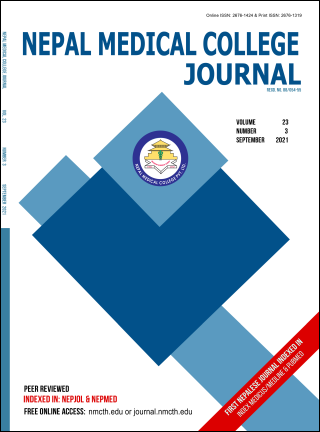Bifurcation of Common Carotid Artery in Relation to Vertebral Level in Nepalese: A Cadaveric Study
DOI:
https://doi.org/10.3126/nmcj.v23i3.40380Keywords:
Common Carotid Arteries (CCA), External Carotid Artery (ECA), Internal Carotid Artery (ICA), Cervical vertebral level (C1-C5)Abstract
The principal arterial supply of the head and neck are the two Common Carotid Arteries (CCA), they ascend in the neck and each divides into two branches, the External Carotid Artery (ECA) supplying the exterior of the head, neck and the Internal Carotid Artery (ICA) supplying the cranial and orbital cavities. Atherosclerosis of the carotid arteries is a major cause of stroke and transient ischemic attack and it increases with age. The present study was observational based descriptive type, conducted to identify the CCA bifurcation in relation to cervical vertebral level. A total number of 18 cadavers (16 males and 2 females), right and left side of cadavers were studied by dissection method in the Department of Anatomy, NMCTH from February 2020 to February 2021. The ethical approval was taken from NMC- IRC (Ref no- 026-076/077). In present study the frequency of CCA bifurcation in sixteen male Nepalese cadavers (32 samples) on the right and left side was observed and found high level of bifurcation on 31.25% and 37.5% respectively and normal/ standard on the right and left on 68.75% and 62.5% and there were no findings of low bifurcation of CCA. In two female cadavers (4 observations) the level of bifurcation was same on both the side at the level of C3-C4. The Carotid artery injury is possible in different neurological and head and neck surgery. Therefore, the knowledge of variation in level of bifurcation of CCA in different population will be referential to reduce the iatrogenic injury.
Downloads
Downloads
Published
How to Cite
Issue
Section
License
Copyright (c) 2021 Nepal Medical College Journal

This work is licensed under a Creative Commons Attribution 4.0 International License.
This license enables reusers to distribute, remix, adapt, and build upon the material in any medium or format, so long as attribution is given to the creator. The license allows for commercial use.




